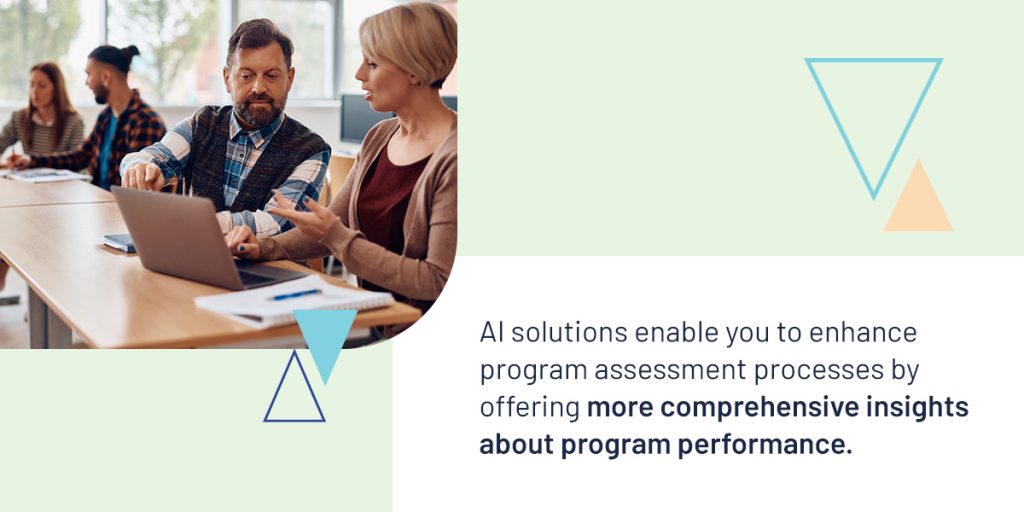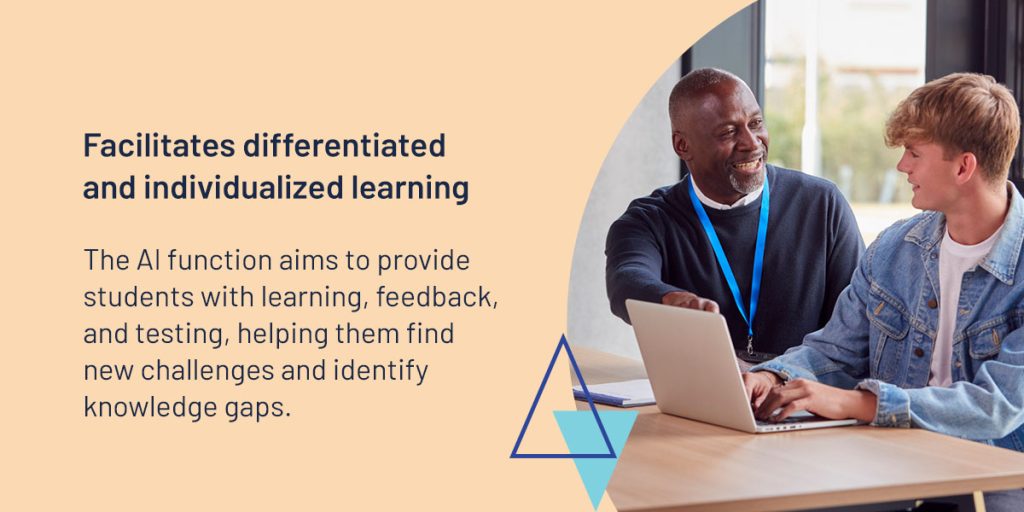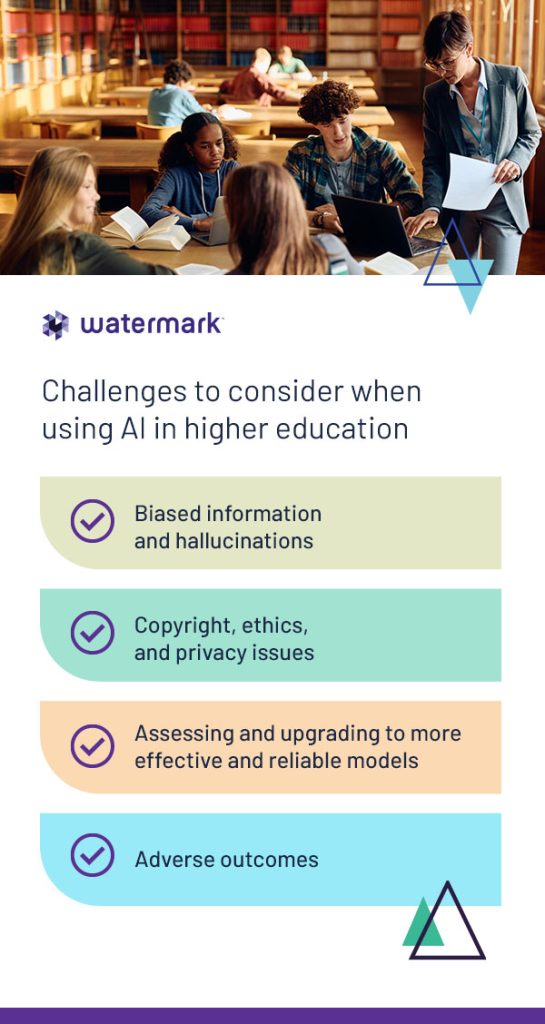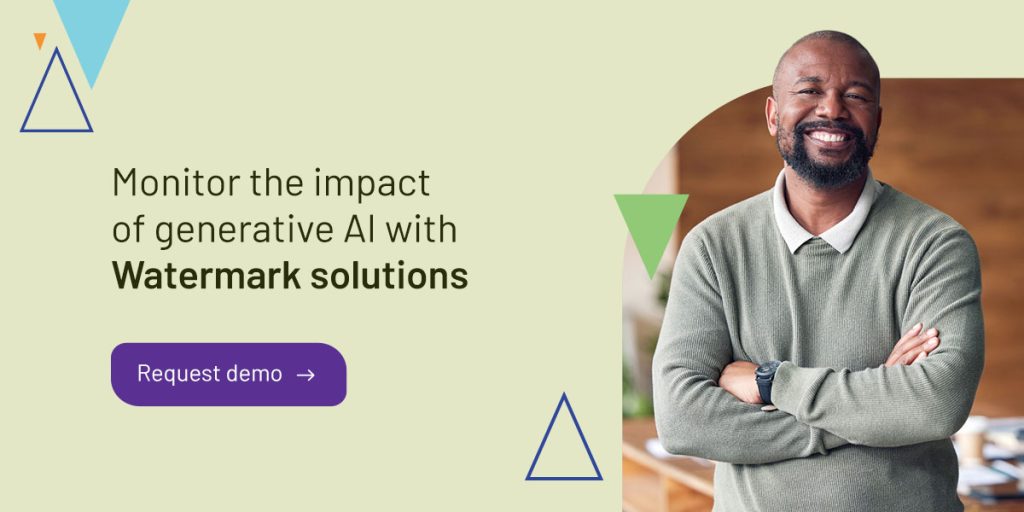




The use of artificial intelligence (AI) in higher education institutions is becoming more prominent as they become more advanced. These tools, depending on their main purpose, can be more efficient than humans, reduce the chances of human error, and provide more comprehensive data for deeper insights.
These opportunities are now available for institutional research (IR) and institutional effectiveness (IE) professionals to use in research and discovery. They can enhance various areas like extensive data collection, predictive analytics, enhanced strategic planning, and continuous improvement. This guide explores how AI is impacting institutional research specifically, its importance, and the challenges to be mindful of.
Technology advancements like Big Data have helped higher education processes grow, enabling enhanced decision-making, process automation, and insight gathering. AI and machine learning (ML) algorithms find patterns, learn, and gradually develop an understanding of information. It does so by examining high volumes of scenarios, iterations, and manipulations.
While text-generating AI bots are more popular now, generative AI may soon be able to offer more assistance in literature searches and other institutional research. When used correctly, AI can assist with student success, inclusion, transparency, accountability, and accessibility in higher education.
AI in higher education has many opportunities and implications for IR and IE professionals. These multi-talented professionals have broad skill sets and vast knowledge of identifying issues within an institution. These skills may allow them to collect, analyze, and manage data efficiently, even in evolving and highly technical environments.
So how can you use AI data to offer decision support for student success, diversity, and accessibility? How can your IR or IE professionals contribute to AI and ML developments for your institution?
These professionals can enhance their effectiveness by using AI systems to analyze unstructured data from feedback forums and articles. AI tools may become a great asset to IR and IE professionals, complementing their statistical analysis, data visualization, and qualitative data.
Generative AI in institutional research has a transformative impact that continues to drive more consistent and comprehensive findings efficiently. Here are the various impacts of AI on institutional research.
AI tools can provide real time feedback on institutional performance by continuously analyzing and monitoring data. This allows for continuous improvement because IR and IE departments can make timely adjustments to practices, programs, and policies.
AI tools are often up to date with emerging trends and issues, keeping institutions aware of the latest data. This way, your institution may maintain high quality and effectiveness standards. These insights may also enhance your strategic planning to ensure institutional goals are always aligned with its current and future needs.

AI solutions enable you to enhance program assessment processes by offering more comprehensive insights about program performance. It uses ML algorithms to analyze course evaluations, student feedback, and learning outcomes. This helps understand the program’s effectiveness, strengths, and weaknesses. Using this information, AI provides actionable recommendations for improvement to ensure the program stays effective and relevant. In doing so, the program may continuously meet job market and student needs.
Predictive analytics is transforming institutional research departments. It forecasts future trends and outcomes using historical data. This enables predictive models to identify students at risk of dropping out, allowing institutions to offer targeted support early on. It also improves enrollment trend predictions so that institutions can plan for future growth and allocate the right amount of resources. This provides an excellent way to optimize institutional resources, enhance student retention strategies, and increase student success.
AI tools can also be valuable for enhancing data collection and analysis. Data collection is traditionally a time-consuming process when performed manually. AI solutions streamline this process because they automate data collection. By analyzing a range of sources, AI solutions can ensure that they report consistent and accurate information about faculty effectiveness, student performance, and institutional metrics. These algorithms may also catch trends and patterns a human researcher might miss, helping drive informed strategic planning and decision-making.
Some AI solutions can analyze data on student interactions, preferences, and behaviors. This allows institutions to implement adaptive learning pathways and tailored course recommendations for more personalized learning experiences. These improvements may lead to higher student success and engagement levels.
Something that is becoming increasingly apparent in higher education is the importance of inclusion and equal opportunities. Inclusion and equity assessments are crucial to ensuring all students have the same opportunities. Institutional research AI analyzes data on student engagement, performance, and demographics, identifies gaps, and recommends targeted interventions. This creates unique opportunities to incorporate support programs that foster an equitable and inclusive educational environment.
AI in institutional research can also help generate and refine your institution’s strategic plans. It analyzes comprehensive data sets such as enrollment statistics, academic performance metrics, financial data, and faculty research output. The institution can then use this information to inform strategic planning processes. It also creates a great foundation for strategic decision-making because it identifies trends and projects future scenarios.
Another valuable feature is its ability to compare your institution’s strengths and opportunities for improvement against those of peer institutions. This comparative analysis will help you set more achievable and realistic goals. Some AI solutions can also maintain stakeholder engagement during the strategic planning process. It analyzes feedback from faculty, staff, external partners, and students to establish key priorities and concerns. This ensures your institution’s strategic plan always aligns with the institutional community’s needs and aspirations.
Some AI solutions have interactive dashboards that update in real time rather than simply using static graphs and charts. This allows institutions to take immediate, data-informed action when needed. In addition to AI collecting data faster than humans, this capability allows us to expand our scope of data exploration dramatically.
This creates a larger scale for data analysis and helps us visualize potential future outcomes more clearly. This includes numerical figures stating expected enrollment figures, student performance data, and other institutional success metrics. These visualizations help improve interdisciplinary collaboration and research communication, allowing policymakers and stakeholders to easily understand data and support institutional decisions.
Do your faculty members manage a large number of students per class? Adjusting teaching methods according to each student’s particular needs can be crucial to enhancing students’ success. If your faculty members find it challenging to do so with a large class, AI may provide the level of differentiation their students need.
Content Technologies and Carnegie Learning are examples of companies working toward developing intelligent instruction designs and digital platforms that use AI. The AI function aims to provide students with learning, feedback, and testing, helping them find new challenges and identify knowledge gaps.

It’s believed that in the future, AI may even be able to read student’s expressions to understand when they are struggling and provide them with a modified lesson. Now, that’s something that’s really going to help those faculty members with numerous students.
One time-consuming and labor-intensive task in institutional research is manually analyzing resources for underexplored areas that may lead to new discoveries. This crucial process typically identifies gaps such as diverse perspectives, limitations in timeliness, methodological approaches, contextual validity, theoretical frameworks, and overlooked variables. Institutional researchers might discover uncharted territory from past studies, use innovative methods to combat persistent issues, or re-examine known issues from a fresh perspective.
AI can be a huge help in these situations when researchers have a large amount of data to study. AI-powered platforms use machine learning techniques and advanced algorithms to identify hidden gaps and visualize connections between various studies. This improved visualization helps trigger research questions and new insights that can lead to potentially promising paths for the institution.
A literature review is an important first step for many research studies, helping to create a solid foundation. That’s why it requires precise organization and planning. Some AI platforms now use natural language processing (NLP). These use simple language to create easy-to-understand summaries, generate initial drafts identifying key trends and findings, and identify content related to the research. AI platforms may also synthesize vast amounts of information by categorizing academic documents, providing more precise direction, and highlighting key themes.
AI assistance may also ensure that researchers do a thorough investigation of all relevant studies for complete coverage. With a solid research foundation, you can ensure researchers spend more time on crucial factors of their research.
Researchers must present their findings clearly and persuasively in a way that scholars understand. AI-powered tools like Grammarly and large language models (LLMs) like ChatGPT may serve as intelligent writing assistants. They identify spelling and grammatical errors and provide constructive feedback to improve coherence and clarity.
As a result, their work will be more accessible to a broader audience, and they will be able to communicate their ideas effectively. AI tools may also automate formatting citations and bibliographies based on the researcher’s chosen referencing style, helping them save valuable time and reduce the chances of manual errors.
Some tools may also cater to those with a different first language or those who have hearing or visual impairments. These tools might include translators, real time subtitles, or text-to-speech readers, which may even assist students who are unable to attend the institution physically.
While AI and ML models hold great potential for institutional research, it is still important to be aware of the ethical uses of AI and a researcher’s responsibility when using AI. The Association for Institutional Research (AIR) Board of Directors has a guide called the “AIR Statement of Ethical Principles.” This guide aims to build awareness of how to express professionalism, integrity, and fairness ethically.
AIR recently updated this guide to address challenges with using AI, and we’re going to zoom in on those issues and the perspectives of industry professionals. Let’s explore these potential challenges of AI and how to combat them effectively for efficient use across processes.

AI is typically trained on existing online data and the language of those using the AI tool. This makes it easy for some underlying data to carry biases that may offend certain groups of people. Releasing such results may compromise an institution’s principles of fairness and equal educational opportunities and reinforce existing inequalities. Sometimes, AI may also create false information or hallucinations that seem convincing.
These qualities make it important for institutional researchers to be mindful of the way they create prompts for AI models. This can involve using more positive words to describe minority groups and modeling fairness to train generative AI tools to be fair and more objective. Researchers should also double-check any information discovered or stated by AI to ensure accuracy.
Another challenge of generative AI is its data privacy and confidentiality. In a study about the ethics of ChatGPT, institutional professional Partha Pratim Ray states his concerns about data privacy since the interactions of researchers may be tracked. This makes it important for researchers to handle sensitive information, such as behavioral patterns and student performance, responsibly and for institutions to develop policies that protect user data.
Some AI-produced information may also be snatched straight from other resources without any changes. To avoid copyright issues, researchers may need to run their work through a plagiarism checker.
As new AI tools emerge, institutions need to question whether the model with be reliable and effective. This makes it essential to do research on these AI solutions, read reviews, and ask the provider questions about any concerns for more clarity on its abilities.
In some cases, researchers may experience adverse outcomes, such as gaining negative attention for using AI. This may happen when researchers miss inconsistencies in information, outdated information pulled from AI, or inaccurate facts and statistics. This is another reason why fact-checking is important before releasing study findings. It may also help to work with AI solutions that have a reputation for providing more accurate data.

Generative AI and machine learning for institutional research can be very beneficial in improving efficiency, accuracy, and effective delivery. AI solutions for evaluating courses, feedback, and student and faculty success may be a reliable option for evaluating institutional success and opportunities for improvement.
Watermark Course Evaluations & Surveys may be a valuable solution to help institutional researchers gain deeper insights. Our solution simplifies the course evaluation process and converts its results into actionable insights. It provides immediate insights into more beneficial teaching methods and resources for current and future students. To collect relevant data more effectively, request a demo with Watermark today.





























































































































































































































































































































































































